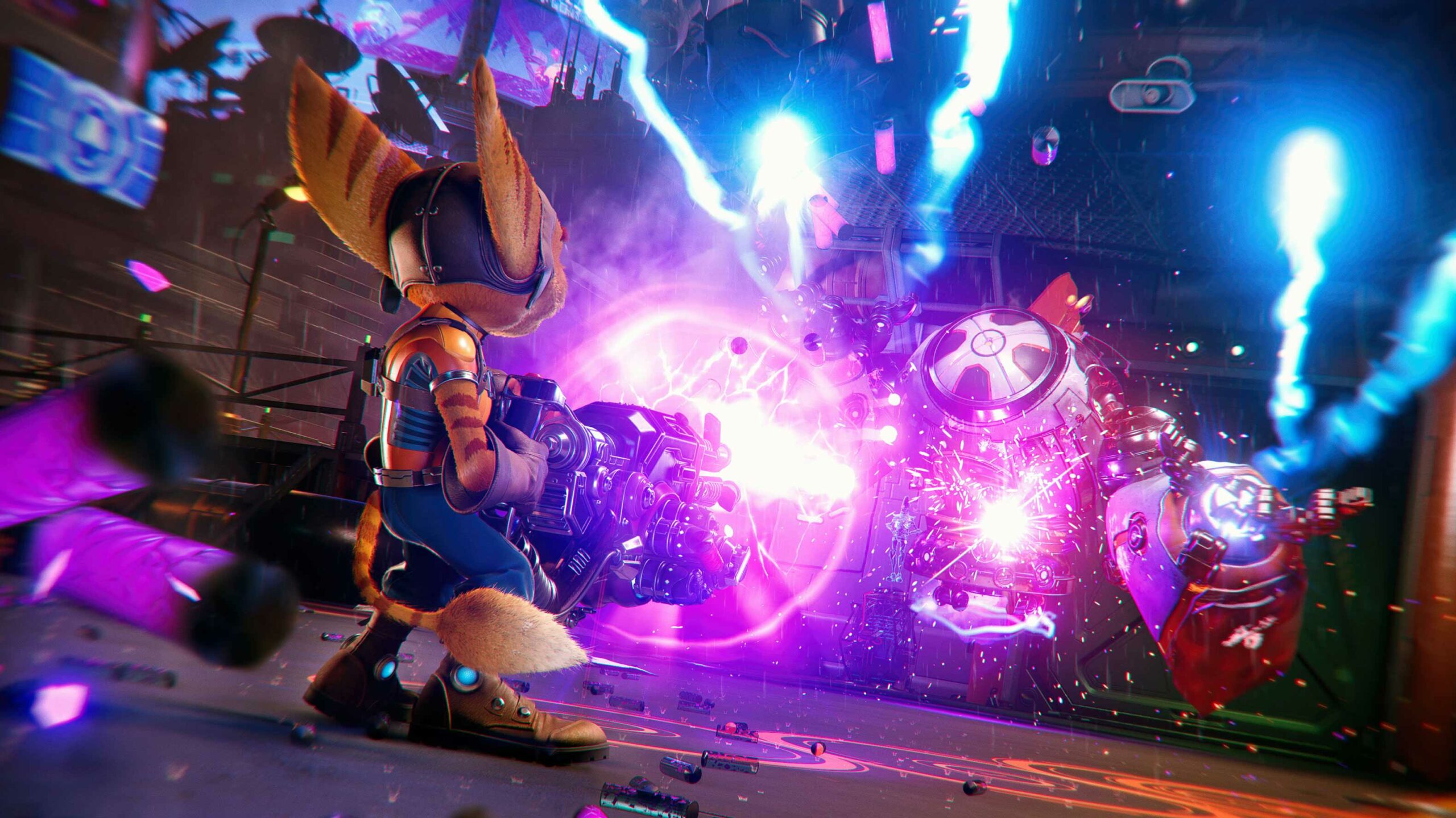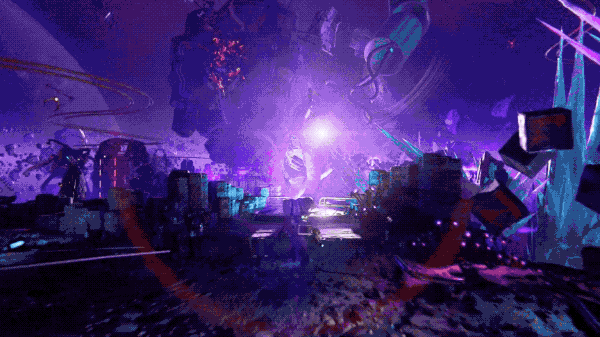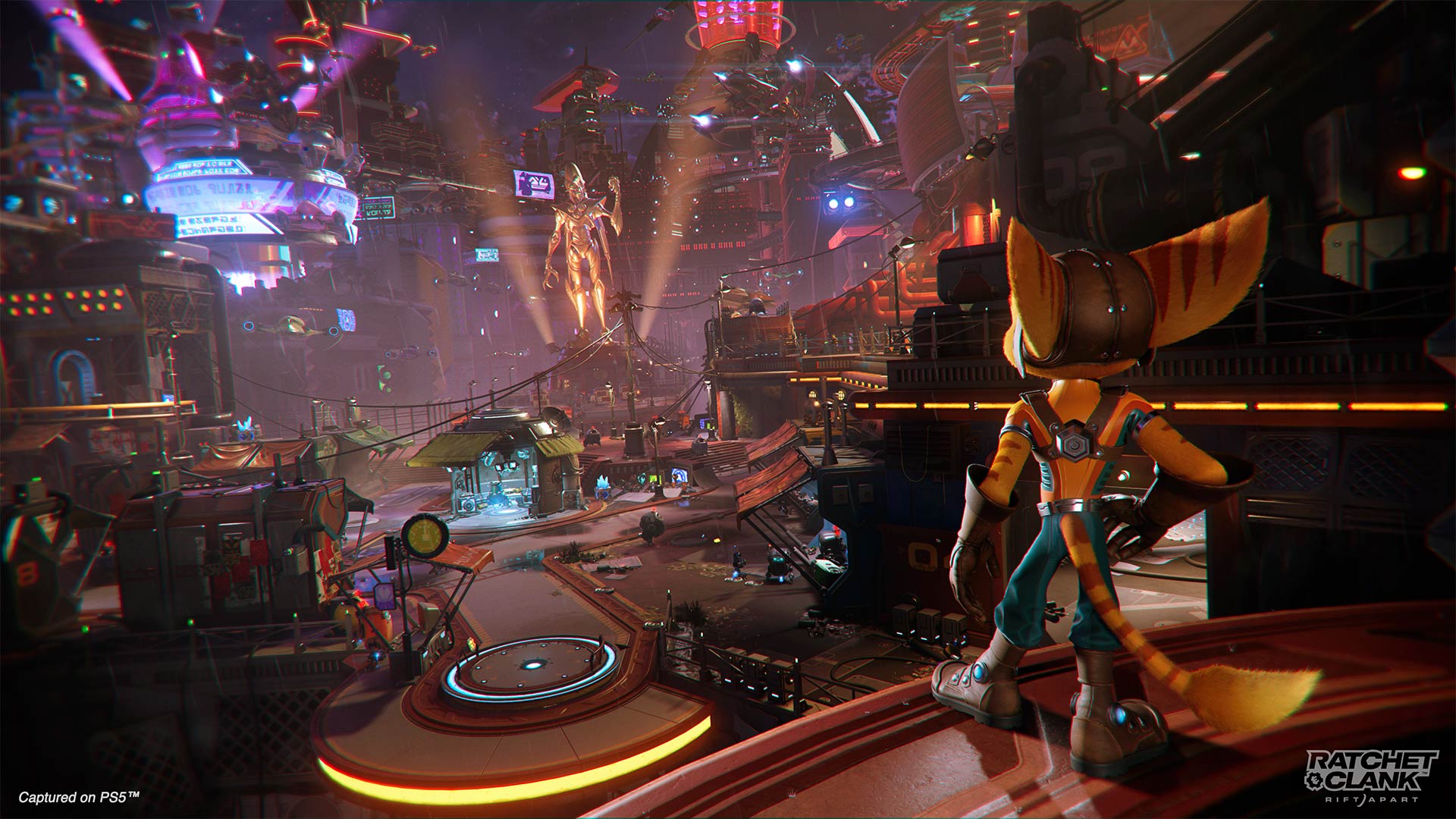
When the PlayStation 5 launched in November, Insomniac supported the console in a big way with Marvel’s Spider-Man: Miles Morales, a brilliant follow-up to its excellent 2018 Spider-Man adventure.
However, Miles Morales also released on PlayStation 4, so its PS5-unique features — improved visuals and frame rate, SSD-powered rapid load times, haptic feedback and more — were great technical enhancements to an otherwise last-gen game.
That’s not the case with Ratchet & Clank: Rift Apart, though. The latest entry in Insomniac’s fan-favourite action-shooter-platformer series is being developed exclusively for the PlayStation 5, which enables the Sony-owned developer to truly take Ratchet and Clank to the next level.
In particular, the game follows our heroes (plus a new female Lombax named Rivet) as they make their way through different dimensions, with the PS5’s SSD enabling seamless, instant travel between these rifts — sometimes even during traversal or mid-battle.
To get a better idea of the slew of technical improvements offered by the PS5 in the latest Ratchet & Clank, MobileSyrup spoke with Mike Fitzgerald, Insomniac’s core technology director on Rift Apart. Read on to hear him unpack the game’s stunning visuals, SSD-powered multidimensional setpieces, DualSense controller features and more.
Question: To start, I have to ask about the visuals. Many people, myself included, have been blown away at how stunning the game is [in 4K/HDR, with an optional 60fps mode that lowers resolution].
It’s a bit of cliché to say at this point, but it really does look like a playable Pixar movie. I’m curious, how much did you need to push your technology, especially since the last Ratchet & Clank was more than five years ago?
Mike Fitzgerald: Thank you! [laughs] First, I’d say more so than us pushing the technology, I think in a lot of ways, the technology has been pushing us to work on our engine and rethink some of the assumptions that are built into it from previous generations — to really push it further and further. A good example is switching from the spinning hard drive in the previous generation to the solid-state drives and the decompression engine and the IO hardware around it in the PS5 has been a huge shift from an engine technology perspective.

Mike Fitzgerald, Insomniac’s core technology director on Rift Apart
And so a lot of our progress on this game has been about pulling out this stop here, or restructuring how we load this system, because we always assumed things would take 10, 100 times longer than they currently do. That’s where a lot of our wins from loading have happened, and those contribute to graphical enhancements and visual enhancements, both during development and at runtime. Mostly, the new beginning of a new console generation is great because you just have a ton of new power and hardware and techniques to play with and discover and layer together. And you get to see some improvements really quickly.
Q: Even as a cross-gen title, Miles Morales — and by extension, Marvel’s Spider-Man Remastered — offered gamers an early glimpse at the PS5’s capabilities. With that in mind, what lessons did you learn in developing those games for the new hardware that you carried over and built on in Rift Apart?
Fitzgerald: Those games are your traditional open-world titles — you know, a big Manhattan [setting] you go through — and we had to work on our streaming infrastructure a lot to support that type of game. And it’s been interesting, [as] a Ratchet game has never been structured that way before; you load the level, you’re in the level, you play the level. And even though our worlds now are smaller than Manhattan in the Spider-Man titles, we still structured them that way — we still have them stream in and out as you move through them. And that has led us pack way more fidelity and asset density and quality into the areas you’re in because then we can use all the memory we have for just that.
Q: You talked about “streaming” content in Rift Apart like you would in an open-world, so I’m kind of curious if you can kind of put that into context. How much denser is, for example, the opening Metropolis level in Rift Apart compared to, say, the early city level in Ratchet & Clank in 2016? Roughly how many more assets — objects, enemies, characters, etc — can you have on-screen at once in Rift Apart compared to previous games?
Fitzgerald: I don’t have numbers off the top of my head, but just qualitatively, you can see in some of our demos that we have NPCs [non-player characters] running around and wreaking havoc in the areas that you’re in. You know, pedestrians — they all have luggage and stuff. There’s a lot more happening from a physics and destruction standpoint than happened previously as well. There’s things that can break into multiple pieces that hang around for a lot longer or fly around based on the weapons that you’re using.
And just the areas in general. People are very complimentary about the previous Ratchet & Clank title and how it looked. But I feel like you can see the difference when you go back to it, that you sort of have that static world that things exist inside and little combat encounters. And what we tried to do here was have a more dynamic world with lots of things going around and moving and combat encounters that sort of weave their way throughout the whole time.
Q: One of the other big technically impressive elements of Rift Apart that a lot of people probably don’t even fully appreciate is how the SSD is empowering these crazy multi-dimensional setpieces.
How did these come about? When you knew you were making a new Ratchet for PS5, was the idea at the early level that you can have these setpieces where two game worlds are loaded at once? Or is that something that came about as you were playing around with the tech and realized the full capabilities?
Fitzgerald: The concept of the game came from some foreknowledge of the hardware, that there’s gonna be an SSD in here and that will mean loading times are fast. [We thought] this would be a cool way to introduce that to the Ratchet universe. I will say during development that the actual speed we were able to get out of the tech surprised us continually as we went and made us push that even further and further to, ‘can we do this during a boss fight?
“…the triggers add that whole strategic component, and people saw this in [PS5 exclusive] Returnal.”
Can we do it five times in a row so you fall through one [rift] after another after another? So it started with knowledge of the hardware, and that’s let us do some really cool things from a design perspective. And then I think they evolved alongside each other as we figured out how to use it.
Q: Springboarding off that — as you were realizing that the tech limitations were opening up, how did you come up with the idea for these setpieces? Was it sort of a case of others on the team conceptualizing an idea for a zany moment and then they’d come to you to ask if it was possible from a technical perspective? Would you go to them and say, ‘this is something cool that I think we can try out?’ Or was it more of a mix? What did that whole process look like?
Fitzgerald: There’s always some of both. I’d say when it comes from our direction, I think someone will say, ‘hmm, I think we could do this,’ and they put together a little demo. And then for the creative individuals on the production team, that spins out in their head to go, ‘then we could do this, or we could do this, that.’ So we try and inspire in that direction. And I think the other direction is very much the production teams having a crazy idea and then maybe just doing it. [laughs] And then we say, ‘okay, this almost works, and I think we can help you get the rest of the way there.’
Q: In your opinion, what are some of the coolest things being done with the DualSense in Rift Apart? Do you have a favourite? [Note: The DualSense offers unique haptic feedback and adaptive trigger settings, such as partially pulling the trigger versus fully pulling it to toggle weapon effects].
Fitzgerald: There are some very fun ones. This has been fun because we’re seeing a lot of games doing great controller stuff. And they can make a pistol feel different from the shotgun, feel different from the sniper rifle or whatever. But none of them have a mushroom [that] comes out of your weapon and runs around for a while. [laughs] We got to do a lot of really fun stuff in that regard. And then the triggers add that whole strategic component, and people saw this in [PS5 exclusive] Returnal. We’ve been pretty impressed by it in the past few weeks of how you can actually use your guns differently, because of the double stops on the trigger and things. So there’s a bunch of good examples of that, that our team ended up doing in parallel with that title.
Q: Outside of the DualSense features, what were some of the ways that the PS5 let you be more creative and wild for the zany guns that Ratchet & Clank is known for?
Fitzgerald: I’m trying to think of which ones we’ve talked about. I’d say the visual effects team had a blast working on the weapons, and I think a lot of them just look fantastic. And they have tons of particles and crazy stuff going on every time you use them.
Q: Moving onto ray-tracing — I think this is something that a lot of gamers, especially those without PS5s at the moment, maybe don’t quite fully appreciate. Or they know it mostly for something like Miles Morales, where it’s a reflection of his suit on a building’s window.
So what is it about raytracing that you think is is notable moving into this generation? And what are some of the ways that you’ve been applying it throughout Rift Apart — perhaps in ways that players might not necessarily even understand is ray-tracing?
Fitzgerald: Yeah, there are mirrors, and they can reflect things. And you will see that [in Rift Apart], and that’s what happens in Miles Morales a lot. But it also just affects every material in the game that has some specularity or gloss to it. And being a sci-fi game in a sense, there’s a ton of different metals — our antagonist [Dr. Nefarious] has a giant glass dome on his head, right? [laughs] Our artists put tons of those around.
“…there’s been a huge challenge for the teams recording dialogue with actors who are hoping to do performance capture and things like that.”
And it really does ground the characters against those sorts of different materials they’re near and around. The best example, I think, is in one of the recent trailers. There’s a shot of Clank and Rivet in her spaceship — you’re in the cabin of the spaceship looking at them. And even though there’s not a reflection near them, as they move in their seats or the camera shifts or whatever, you can see all of that playing off little metal domes in the background, or the spaceship controls that they’re holding and things. I think that really does close a big gap towards that ‘animated film feel’ like you mentioned.
Q: Given that you’ve been developing this game for new, complex hardware, how difficult was that to transition to remote work? I think it’s fascinating how developers like you can make such stunning games from home, so I’m curious what sorts of challenges there might have been with that, especially for a new system like the PS5.
Fitzgerald: Yeah, it’s been a huge challenge. I’d say as a studio we had a nice leg up. We have a North Carolina studio and the Burbank, California studio that were already working together on all these titles. And so we’ve used Zoom, we had a bunch of experience working with people remotely, having some infrastructure for shuttling game builds around different places, and out of the office and things like that. But our IT team did an awesome job getting everyone up and going with minimal downtime. And we’ve just learned a little bit differently how to do reviews, share builds with each other, talk about things, keep motivated.
And certainly, there’s been a huge challenge for the teams recording dialogue with actors who are hoping to do performance capture and things like that. I think for this team, all the actors recorded everything at home in home studios that we help them set up or they had already. But I mean, everyone in the studio is really proud of the fact that we were able to ship [Miles Morales] for launch last year under those conditions. And this game, too, has really turned out pretty nicely.
Q: Evidently, there’s a lot of cool tech elements to Rift Apart thanks to the PS5. Of all of them, what was perhaps the most difficult to achieve that you’re ultimately most proud of having gotten in the game?

Fitzgerald: Oh, man. In the last trailer, we showed a little clip of the character [Rivet] standing in front of that crystal thing and hitting it, and it’s swapping. And it’s the two dimension versions of one world. And I think you’ve seen a lot of games before that have some mechanic of switching environments like that, and they’ll do it by keeping them both loaded, and just showing you when you’re in.
And that is really like no tricks at all — hit the thing, un-load the one you’re in, load the new one, and you’re there. And we’ve even pushed it a bit further than you saw in those videos since as we’re approaching launch and cramming as much as we can into the final versions of the game. And it is really, really startling when you do it that all of a sudden you’re somewhere else. And it’s one thing to watch another video, and it’s really something else to actually play it. I’m excited for people to get to try that out.
This interview has been edited for language and clarity.
Ratchet & Clank: Rift Apart launches exclusively on PlayStation 5 on June 11th. For more on the game, read our coverage of a recent virtual Rift Apart media preview hosted by Insomniac.
Image credit: PlayStation
MobileSyrup may earn a commission from purchases made via our links, which helps fund the journalism we provide free on our website. These links do not influence our editorial content. Support us here.





